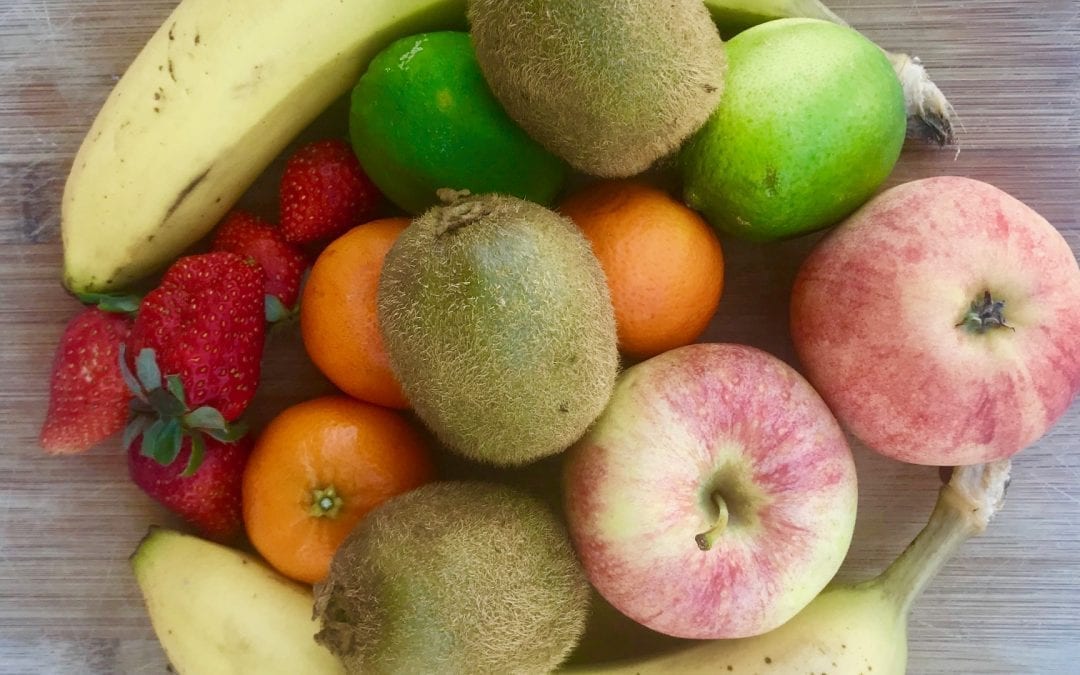I consider myself a donut connoisseur, have no shame in Happy Meals for the littles from time to time, and live for pizza on Fridays, but you won’t ever see me in the juice aisle. Juice: good for mimosas and not much else.
Both the 100% kind and those boxes of sugar juice offer little in terms of nutrition. Generally, you should have 2 to 4 servings of fruit a day. Fruit offers vitamins, minerals, antioxidants, and most of all, fiber. It’s essential in your everyday diet, but grabbing a glass of orange juice is not a fair substitute for the actual fruit. To make juice, the fiber is stripped out completely, and all of the sugars from the fruit are concentrated to form juice. Add some water, and there you have it. If you look at a nutrition label for your favorite brand of juice, chances are the dietary fiber will say 0, whereas an orange has 3 to 4 grams of fiber. With a Daily Reference Intake recommendation of 25 grams of fiber per day for a 4-year-old, every little gram counts.
I grew up with Hi-C being a staple in my lunchbox (& while I think I turned out okay), juice (especially those that are not 100%) is essentially like soda for your kids. If you look at the ingredients for most fruit juice blends, water is the first ingredient, followed by sugar or high fructose corn syrup. In what world would you want to give your child a cup of sugar? Don’t be fooled by the “no artificial colors or preservatives” slogan—there is nothing healthy or necessary about some of those boxes. Tooth decay and behavior problems are just two repercussions of sugar. Now, don’t think I’m hating on sugar, I’m just encouraging you to save it for the good stuff: cookies, cupcakes, and my previously mentioned favorite, donuts. Think of juice as a treat, not a beverage.
Aside from the fact that juice lacks fiber, is highly concentrated in sugars (whether natural or added), giving your child juice as an everyday drink creates a further problem: their bellies are too full to eat the good stuff. If your kids are like mine they act like they’re dying of hunger all day long, eating all the snacks, but when it comes to dinner, they don’t eat—only to be completely starving again right as they get tucked in for bed. It is more common than not for kids to over-snack (we as parents are to blame but I know throwing some goldfish at a whiny, hangry little one is sometimes easier than not), but adding juice in this mix leads to an inevitable dinner-strike situation. Children’s bellies are much smaller than ours and by filling it with juice, they truly feel full and thus don’t want to eat. Chances are dinner is where all the nutrients are: a healthy grain and hopefully some veggies alongside those chicken nuggets. You can argue they weren’t going to eat those healthy foods anyway, but is it possible a pattern of days full of snacking and juice binging have caused your little ones to be less encouraged to try the foods on their plate?
So, when is juice appropriate? There are times that juice may help offset or lessen the symptoms of illnesses. We had a serious bout with the stomach bug last winter—so bad that we had multiple ER visits due to dehydration. During this time, a doctor informed me that apple juice mixed with water is becoming recommended in gastroenteritis situations—due to its more favorable taste, lack of fiber, and its low price. Granted, my littles weren’t up for drinking anything (even soda and popsicles), and of course every situation is different and some people may require electrolyte solutions, but if the plague strikes your house, consider trying diluted apple juice to get through it. As for the man cold, my husband swears by drinking a whole carton of orange juice when he feels like he’s on the verge of “dying”. I believe in the healing powers of vitamin C, but keep in mind, eating oranges some zinc lozenges would be just as effective, if not more so. Cranberry juice has been used against urinary tract infections, but WebMD disputes this claim, recommending cranberry capsules. I used to work in a health food store and clients did have success treating their infections with the purest form of cranberry juice, but I’m no doctor or specialist and am just here to say whatever you do don’t buy that cranberry cocktail juice blend—it will do nothing for you.
If your child’s school or daycare is providing them with juice as a beverage daily, and you’re as horrified as I am, perhaps suggest fruit instead. Each parent could take turns bringing in fresh fruit. If you frequent smoothie operations, be aware that juice is usually used to blend the smoothie—this is unnecessary and yogurt or almond milk would provide just as tasty of a smoothie without the added sugars. And finally, if you’re hosting a birthday party (which is already full of cake and candy), or maybe you’re providing snack after your child’s sporting event, think water—it’s cheaper, obviously healthier, and no one is going to miss the alternative.
I hope you can take away something valuable from my rant on juice and also remember that it is all about balance. You’re not a bad mom if you buy juice for your child’s Halloween party at school, but being aware that it’s a treat, and not a beverage or fruit serving, may change your perspective from here on out. Save all the juice for you mama, you deserve a mimosa after a sleepless night and a day in the #momlife.


Great post!
This is really informative article. Fruit offers vitamins, minerals, antioxidants as you say but if you want 100% from fruit then you need to make it juice. Juice is the great way to get exact nitration.